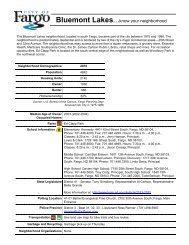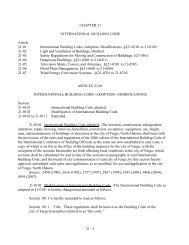Create successful ePaper yourself
Turn your PDF publications into a flip-book with our unique Google optimized e-Paper software.
water) to the filter in an amount sufficient to cover the sand. Soak the sandseveral hours, re-circulating through the make-up water tank when possible.Drain to waste and thoroughly backwash.The filter piping should have a re-circulation line to permit re-circulation <strong>of</strong> the water fromthe effluent back to the influent for chemical cleaning <strong>of</strong> the filter media. This line should beabout one-half the size <strong>of</strong> the main return piping.Sand contaminated with oil and grease had been traditionally cleaned with a lye solution.This procedure should only be used if other materials are not effective. Lower the waterlevel in the filter to within 2 inches <strong>of</strong> the top <strong>of</strong> the sand and apply the lye at a rate <strong>of</strong> 1pound per square foot <strong>of</strong> the sand surface. Allow the upper portion <strong>of</strong> the sand to soakseveral hours and slowly empty the filter to waste. Follow with a longer than usualbackwash. This treatment will prevent replacement <strong>of</strong> costly filter sand. Provide adequatewash water flow rates to prevent further accumulation <strong>of</strong> such conditions. Use extremecaution when handling lye as it can cause severe burns. Lye is particularly destructive to thetissue <strong>of</strong> the eye and may cause loss <strong>of</strong> sight.5.4 HIGH RATE SAND FILTERSHigh rate sand filters may be operated at filter flow rates <strong>of</strong> up to 10 gallons per minute persquare foot <strong>of</strong> surface area (as compared to 2 to 3 for conventional sand filters). Filtration isaccomplished in-depth rather than on the surface, thereby, increasing the dirt holdingcapacity <strong>of</strong> the filter.Operation and cleaning <strong>of</strong> high rate sand filters should be compliant with the instructionssupplied by the manufacturer. Usually the filter is back-washed when the differentialpressure reaches 25 psi. The design <strong>of</strong> the under drain system causes strong agitation,rubbing together the sand grains to release suspended materials. Trade literature indicatesthat the collected solids are generally discharged during the first minute or less <strong>of</strong> backwashwater source within about 2 minutes. Recommended backwash periods vary, but for somefilters it is approximately 2 ½ minutes.High rate sand filters have had erratic success in North Dakota. Operation <strong>of</strong> the filter at aconsiderably reduced flow rate after back washing may prove beneficial. The reduced flowwill allow the suspended materials to collect and settle on the sand, rather than being drivencompletely through the clean filter media. Once a coating <strong>of</strong> suspended material has beenbuilt up on the filter surface, the flow may be increased to the normal re-circulation rate.5.5 DIATOMACEOUS EARTH FILTERSThis type <strong>of</strong> filter has several advantages over the sand filter; greater removal <strong>of</strong> turbidity,smaller size and the elimination <strong>of</strong> chemical coagulants such as alum. They also require verylittle water for back washing.20












